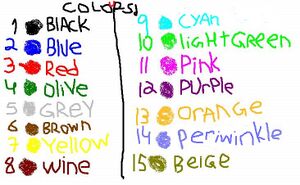UnNews:Scientists discover that colors are the same color all over the world
| This article is part of UnNews, your source for up-to-the-picosecond misinformation. |
1 November 2006
Scientists discover that colors are the same all over the world, except in winter
Berlin, Asia (AssPopping) In the late 1960s the prevailing view was that colors were different all over the world, what a tribesman in Africa saw when shown a matador's cape, was thought to be very different from what a Seattleite (pre-Grunge only) saw when displayed the same cape at different geopolitical coordinates. It was thought that these differences were unrelated to the differences in the bending of the sun's rays of light as they entered the earth's atmosphere at different latitudes, different rotational speeds, different cloud covers, and different soil components on various continents.
However, two scientists from Berlin, John Kay and his pesto John Longdongjohns, have recently discovered this not to be true. In an experiment cleverly designed to mimic an earlier experiment which eventually showed that two synchronized watches worn by morons aren 't really synchronized, the experimenters flew around the globe carrying various pieces of cloth and waving them out the window of the plane. Subjects on the ground yelled up at the flying plane what color each piece of cloth was. Controls on the plane then told the scientists what color they thought the person on the ground should have seen.
Using this data, Kay and Longdongjohn were able to conclude that the colors RED, POLKA-DOT, BLUE, SWISS-VOILE, BROWN, OPRAH, YELLOW-or-VIOLET, and GRUE (GREEN-OR-GREEN) were the same in Africa, Asia, Australia and other countries with names beginning with A. Experiments in the Arctic and Antarctic were inconclusive as it was night in one of them, and the subjects were eaten by polar bears in the other.
This research was supported by an NSF grant number ABP123InATree, and probably and NEA grant, too.
